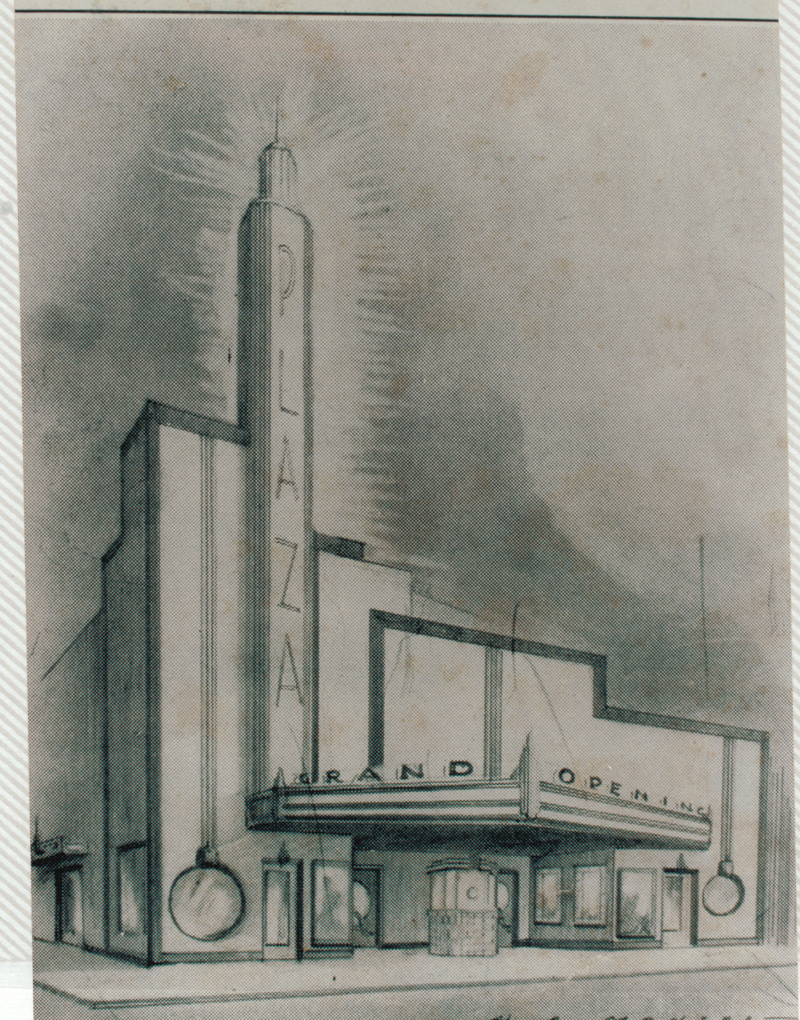This article originally appeared in the Garland/Mesquite section of The Dallas Morning News on December 1, 1995.
By Michael R. Hayslip
Garland’s Plaza Theatre was once the flagship of a five-unit movie combine owned and operated by Harold R. Bisby and his wife Jennie. There was no business like “picture-show” business, and besides their three locations in Garland, the couple operated The Plaza Theatre in Rockwall and The Wylie Theatre as well. Theirs was the primary entertainment game in the entire area.
The Bisbys, he raised in Kansas and she in Iowa, had settled in Garland in 1937, arriving with decades of entertainment industry experience between them. Their first venture was the Garland Theatre at 618 Bankhead (now Main Street). By 1941 they had begun construction of the Plaza, located at the northwest corner of the town square, from a 1918-vintage structure formerly occupied by the Cole & Davis dry goods establishment. Their third Garland site, the Texan Theatre at 510 Bankhead, opened in 1947.
Commissioned to design the original Plaza was H. A. Manzer, a veteran local lumber dealer who dabbled in architecture and other artistic pursuits. Mr. Manzer created a classic Art Deco facade, employing ornamental stucco and maroon colored glass, for the 50-by-140-foot structure. Flanking the central ticket booth on either side of the doorway were spaces for small shops, and, inside, a balcony was created to expand seating area for 700 persons. Although no cost figures were published for the private venture, the Bisbys proclaimed that the Plaza was equal to any $50,000 theater in the state.
Opening night was April 4, 1941, Garland’s 50th birthday, and almost every ambulatory person in the town of 2,500 showed up at one time or another during the day. Featured was a showing of Western Union, starring Robert Young and Randolph Scott. Both Clint Sutherland’s portrait studio and Ms. Clem Murphree’s dress shop occupied the theatre shops.
Staffing the theatre were corps of local residents, including high school students, many of whom encountered their first business experience under the watchful eye of Jennie Bisby. One of these staffers between 1945 and 1948 was Bill Holmes, who rose through the ranks from usher to popcorn popper to projectionist. Although he describes his pay as uninspiring, he admits ready access to the concession booth and still recalls that there were 164 kernels in the average nickel bag of Plaza popcorn. In unsupervised slack time the future chemical engineer also conducted scientific experiments by setting fire to one end of a film reel, which was rolled across the street for a momentary line of flame to test the response time of I. H. Huffaker, Garland’s only patrolman in those days.
During 1948 the Bisbys added a ”Polar Air” refrigeration system to the Plaza. Compressors for this early air conditioning were positioned in a basement well beneath the projection stage, and signs with a polar bear emblem appeared on the front of the building. On occasions when the machinery was reluctant to function, hammer blows about the compressors usually coaxed them into action.
In 1950, the building was remodeled again, stem to stern, this time designed by Dallas architect Jack Corgan. Walking over new terrazzo past the Denzil Graves mural of ballet dancers in a Cindarella motif, opening-night patrons enjoyed leather seating, high-intensity arc lamp projection and an added “cry room” for noisy children, while they viewed the film Thelma Jordan, with Barbara Stanwick and Wendell Corey. Cartoons for the evening featured Bugs Bunny and Pluto, and Mr. Bisby reiterated that management’s objective was to “provide for Garland only the best of clean, wholesome family entertainment.” Nevertheless, many younger couples continued to become better acquainted in the private shadows of the Plaza.
By the late 1950s, with many of Garland’s 25,000-plus residents now developing affection for their television sets, the Bisbys had withdrawn from active theater management to pursue their many civic interests full-time. The Plaza was subsequently leased to a series of entertainment occupants, and over time the building fell into disrepair. Most of the roofing material had already collapsed and floated downstage when John Skelton, trustee of the Bisby estate, donated the property to the City of Garland in 1992.
After a major cleanup that year by employees of Garland Power and Light, the Garland Cultural Arts Commission, appointed by the City Council and assigned administrative oversight of the facility, secured a $120,000 federal funds grant to clean out asbestos, repair the roof structure and install new roofing. Since that work was completed in 1994, the Plaza has been mothballed in dry-shell form, awaiting future renovation as a multi-purpose civic center providing needed meeting and assembly space for the city.

Rendering by H. A. Manzer of the original Art Deco facade of the Plaza Theater on the Garland square.

